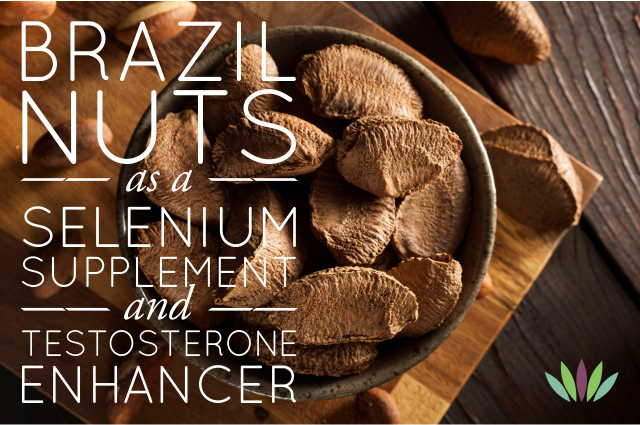Brazil nuts are an unusually powerful superfood. As the richest known natural source of selenium, they have many health benefits, but also need to be eaten with caution.
Here’s how to use Brazil nuts as a selenium supplement, why they are superior to supplemental selenomethionine or selenium selenite found in multivitamins, and how eating Brazil nuts may increase your testosterone levels – good news for both men and women.
The Importance of Selenium in Your Diet
Brazil nuts are exceptionally high in selenium, an essential micromineral and antioxidant used by your body to prevent free radical oxidative damage to your cells.
While you only need a small amount of it, without adequate selenium, you can have problems making enough glutathione peroxidase within your cells.
Glutathione peroxidase is a substance critical for cellular detoxification. It converts toxins into harmless byproducts that your body eliminates and provides important protection against many environmental and dietary hazards.
Increasing glutathione peroxidase production is believed to help prevent cancerous cell changes and selenium supplements have been shown in research studies to reduce cancer risk.
Skin complaints like acne and psoriasis, as well as joint problems like rheumatoid arthritis, have often been reported to respond well to extra selenium in the diet.
Selenium is also necessary for a properly functioning thyroid. Since your thyroid controls your body’s metabolism, inadequate levels of selenium may be a factor in sudden weight gain or weight loss.
Selenium Content of Brazil Nuts and Recommended Daily Intake
Selenium is found in highly unusual amounts in Brazil nuts. Just one of these creamy tasting nuts has around 50 mcg of selenium, possibly even as high as 90 mcg. The amount of selenium contained in individual batches of Brazil nuts will vary though, depending on the soils they are grown in.
100 grams of raw Brazil nuts are listed as having a selenium content of 2550 mcg. That’s 3643% of the RDA for selenium.
Even if you could eat that much of such a rich and filling food, you definitely wouldn’t want to. The recommended daily allowance of selenium is 55 mcg a day and just one Brazil nut, on average, will provide close to that amount. If you already eat other selenium rich foods, like shrimp, salmon and crimini mushrooms, that’s probably all you need.Many health experts though believe that the selenium RDA is too low and recommend getting at least 100 mcg a day. Two Brazil nuts should provide close to this amount and this is what I have personally most days, primarily for the antioxidant, thyroid and skin benefits of selenium.
I find just a couple of these organic Brazil nuts particularly good for staving off hunger in the evening if you’re staying up watching a movie.
Brazil Nuts as a Testosterone Enhancer
 Selenium has been shown in research studies to boost testosterone levels in infertile men and many people, particularly in bodybuilding forums, report a greater libido when they eat Brazil nuts regularly.
Selenium has been shown in research studies to boost testosterone levels in infertile men and many people, particularly in bodybuilding forums, report a greater libido when they eat Brazil nuts regularly.
It’s possible that this is simply the result of rectifying a pre-existing selenium deficiency. However, Brazil nuts are also high in zinc, the amino acid arginine and beneficial fatty acids needed to make important steroidal hormones like testosterone. All of these nutrients could play their part in Brazil nuts long-standing reputation as an aphrodisiac (though mucuna pruriens is even more potent).
Women too can benefit in this department. Even though they don’t make or need nearly as much testosterone as men, rectifying a selenium deficiency and increasing nutrients like zinc and arginine with Brazil nuts can have some very positive results in the bedroom.
At the highest levels of Brazil nut intake, athletes, bodybuilders and those with a known selenium deficiency have reported good results in health forums with taking 2 to 3 Brazil nuts for testosterone first thing in the morning and 2 to 3 in the evening before bed.
Unless you are an athlete with higher selenium needs, or known to be deficient in the mineral, I personally think this is getting a bit high for regular use, particularly if you’re eating an especially strong batch of Brazil nuts. Here’s why.
Brazil Nuts, Selenium Overdose and Potential Side Effects
The National Academy of Sciences Institute of Medicine has set an upper limit of 400 mcg per day of selenium for adults and less for children. Just 6 selenium rich Brazil nuts could potentially exceed this amount.
While considered rare, symptoms of selenium overdose and side effects include nausea and even vomiting after eating them, possibly followed by hair loss and skin lesions in extreme cases.
Conversely, serious selenium deficiency can result in muscle weakness and pain, discoloration of the skin and hair and excessive whitening of the fingernail beds.
Clearly it’s important to get enough, but not too much selenium. With parts of the USA, like the Pacific Northwest, the Great Lakes region and parts of the Atlantic Coast, recognized as producing selenium deficient crops, it’s likely that the standard American diet is far from high in selenium.
Why Brazil Nuts are Better than Selenium Supplements
This study on selenium absorption showed participants eating just two Brazil nuts a day, versus those taking 100 micrograms of selenomethionine (a popular supplemental version) had far superior absorption and blood levels of selenium from the Brazil nuts. These nuts also contain good levels of vitamin E, which is believed to enhance the beneficial effects of this essential mineral.
So just one or two Brazil nuts, ideally organic like these that I get every month or two, is superior to supplemental selenium like selenomethionine (and especially selenium selenite found in some multivitamins, shown to adversely interact with vitamin C).
Brazil nuts also contain B vitamins, choline, vitamin E, calcium, magnesium, iron, phosphorus, zinc, manganese and copper in good levels. They could be considered the Brazilian rainforest’s antidote to all the mineral depleted foods in our regular diets.
Have you use Brazil nuts for testosterone enhancement or taken them as a selenium supplement before? I’d really like to hear how they made you feel and how many a day you think works best for you.









